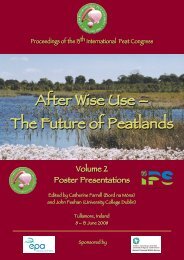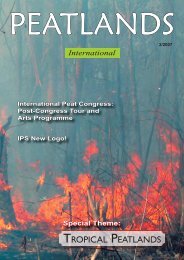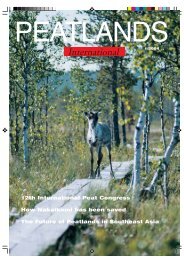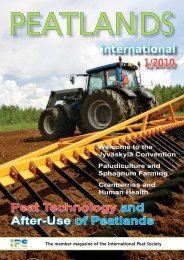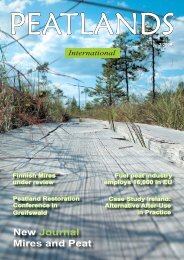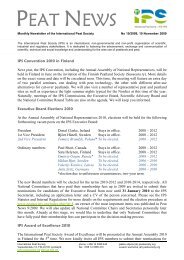peatlands 1 taitto.indd - International Peat Society
peatlands 1 taitto.indd - International Peat Society
peatlands 1 taitto.indd - International Peat Society
You also want an ePaper? Increase the reach of your titles
YUMPU automatically turns print PDFs into web optimized ePapers that Google loves.
Continuation of<br />
the Lower Saxonian<br />
Mire Conservation<br />
Programme<br />
The Mire Conservation Programme<br />
does not have any<br />
limited duration and its aims<br />
will also be valid in future.<br />
However, the agricultural use<br />
of the <strong>peatlands</strong> of Lower<br />
Saxony has already overstepped<br />
its peak. The areas are still used,<br />
but, because of microbiological<br />
decomposition, the fi elds are<br />
literally run down. In future,<br />
water-logged areas, bad drainage<br />
and other problems will<br />
make work for the farmers even<br />
more diffi cult and/or force them to<br />
abandon these fi elds.<br />
In Lower Saxony, the peat industry<br />
has at its deposal only the peat under<br />
the fi elds and meadows in agricultural<br />
use. Today, these <strong>peatlands</strong>, which have<br />
often been in agricultural use for more<br />
than 100 years, are, due to nutrient<br />
accumulation and soil modifi cation, no<br />
longer directly restorable into growing<br />
mires, even if they were rewetted<br />
properly.<br />
Most of the agriculturally-used<br />
former raised bogs have already transformed<br />
to marginal revenue sites, on<br />
which agriculture can not be carried<br />
out effi ciently anymore. Therefore,<br />
the industrial extraction of the peat<br />
from these wet meadows can produce<br />
restoration areas which, in the long<br />
term, can be transformed to new mire<br />
areas. The survey and documentation<br />
of these “returned areas”, guidance<br />
in their preparation and their fi nal<br />
inspection will be one of the most<br />
important tasks of mire conservation<br />
in the future.<br />
The regional development plan of<br />
Lower Saxony designates preferred areas<br />
for peat extraction. These resources<br />
will be suffi cient until the middle<br />
of the present century. Already today,<br />
extraction permissions until 2030 and<br />
further on have been issued.<br />
One special project is the research<br />
on how to cultivate Sphagnum mosses<br />
to be used as fresh biomass instead of<br />
white peat in horticultural substrates.<br />
First trials to initiate the growth of<br />
Sphagnum mosses on cut-over peat-<br />
Restored area after peat extraction at Gnarrenburger Moor. Photo: Gerfried Caspers<br />
lands have started and promise to be<br />
successful. The use of fresh Sphagnum<br />
mosses as an additive in horticultural<br />
substrates has shown encouraging<br />
results.<br />
Mire Conservation<br />
Programme also for Fens<br />
The Mire Conservation Programme of<br />
Lower Saxony originally covers only<br />
raised bogs. However, only if fens are<br />
also considered, will a complete mire<br />
conservation programm be achieved.<br />
Besides the raised bogs, fens are also<br />
typical of the landscape of Lower<br />
Saxony. Often both peatland types are<br />
connected and appear as a spatial unit.<br />
Compared with raised bogs, it has<br />
turned out<br />
that the<br />
protection<br />
and development<br />
of<br />
fens presents<br />
a more<br />
complex and<br />
sophisticated<br />
problem, not<br />
least because<br />
they are fully<br />
under agricultural<br />
use.<br />
While raised<br />
bogs, having<br />
their own<br />
water balance,<br />
can be seen<br />
seperately,<br />
as islands in<br />
the landscape, fens form an integrated<br />
part of the surrounding areas. Their<br />
effective conservation must therefore<br />
extend the area of the fen itself and<br />
also involve the surrounding landscape.<br />
The great success of the mire<br />
conservation in Lower Saxony shall encourage<br />
all stakeholders to move on in<br />
this direction and direct their attention<br />
also to the conservation of the fens in<br />
the Federal State. �<br />
Gerfried Caspers<br />
Eckhard Schmatzler<br />
Landesamt für Bergbau, Energie<br />
und Geologie<br />
Hanover, Germany<br />
e-mail: gerfried.caspers@<br />
lbeg.niedersachsen.de<br />
In former times, peat extraction was a hard work also in Lower Saxony.<br />
Today, museums help to visualize how mires were used by the local<br />
population in the past. Photo: <strong>Peat</strong> Museum in Neustadt<br />
17



